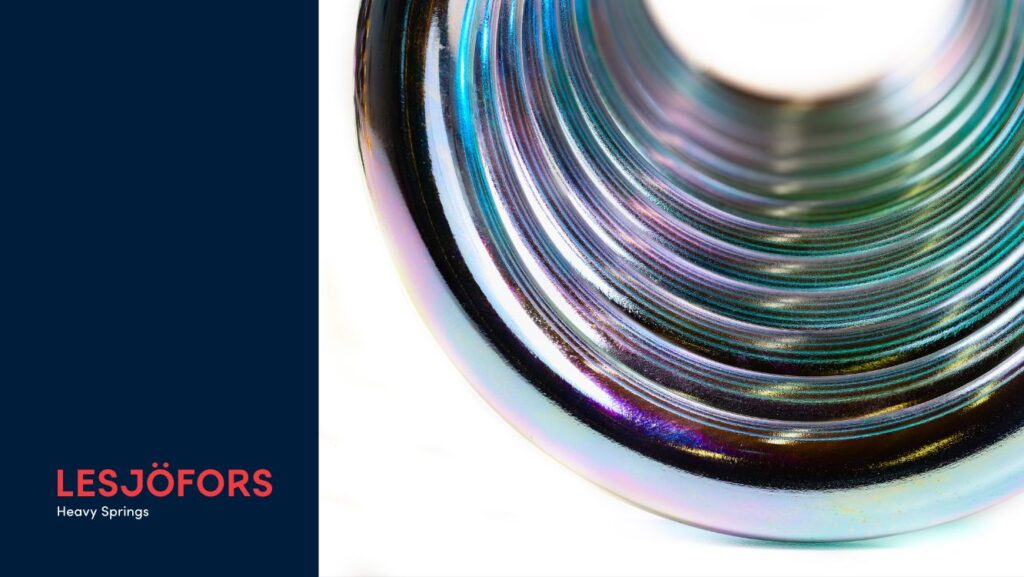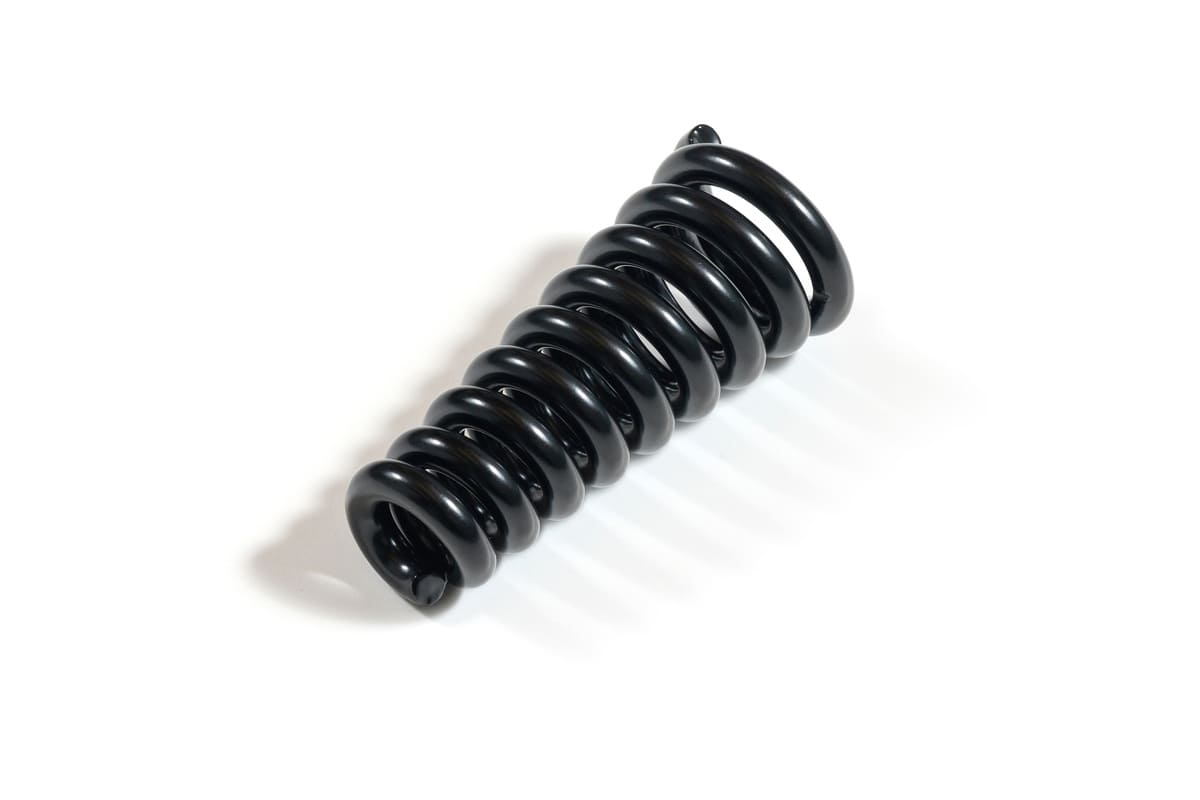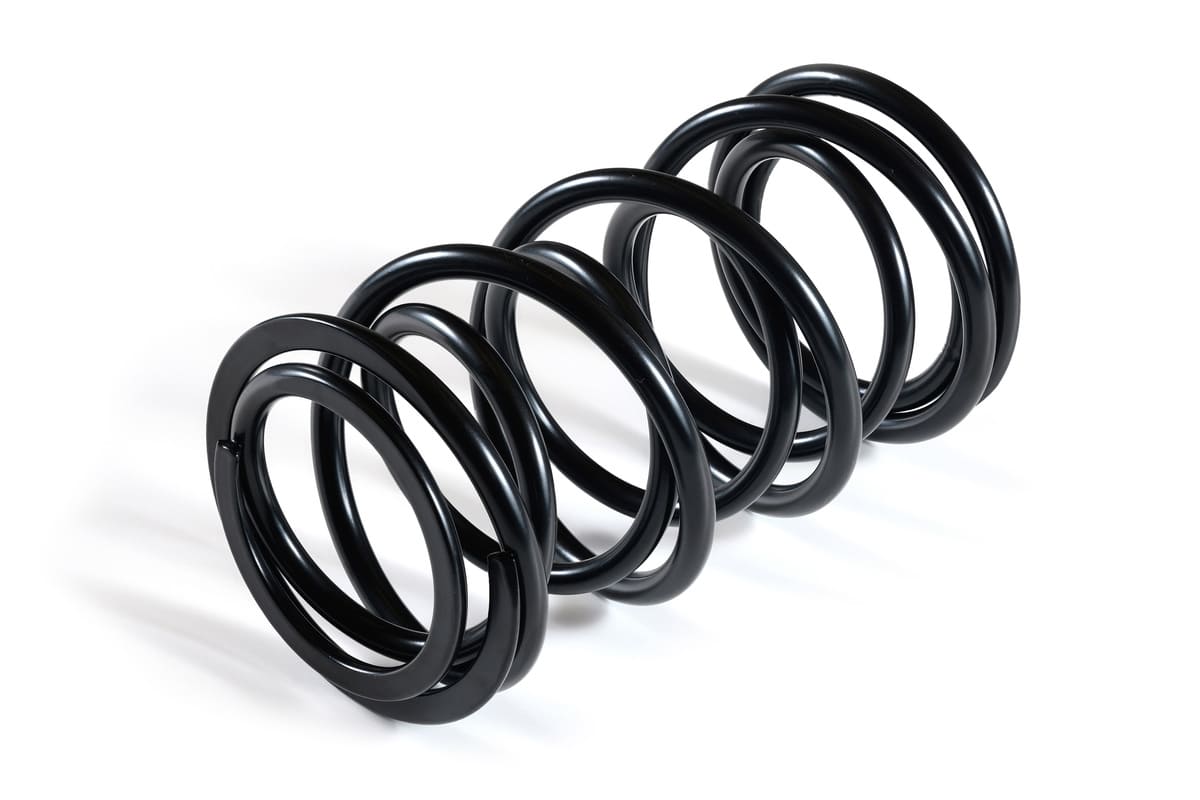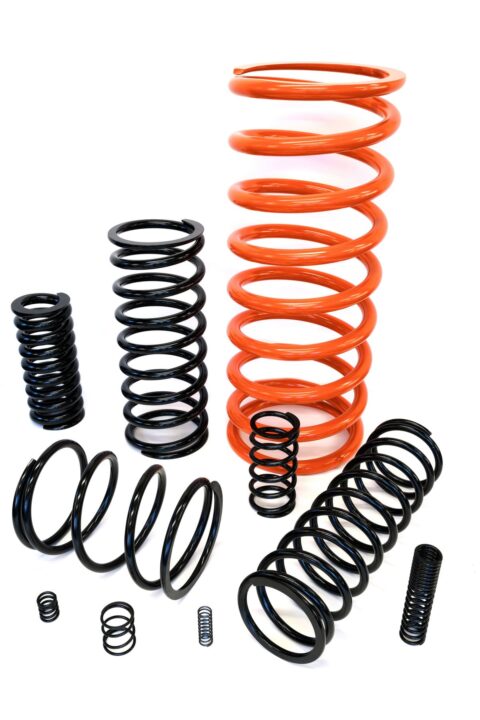
Compression springs have a unique design. Their compressed, helix shape allows them to resist compressive forces and they can be manufactured into cylindrical, conical, tapered, convex or concave shapes with a constant pitch (a spring with the same coil spacing throughout) or variable pitch (a spring with varied coil spacing, delivering varying coil heights across the coil springs length) and with either ground or unground ends.
A compression spring is used in any application that is required to store energy. Applying a heavy load to the compression spring forces it to compress and condense, the wire spaces then reduce in size until the spring’s wire touches, reaching the spring's maximum compressed length.
The coils provide an opposing force when compressed - storing the force until it is released.
Our heavy duty industrial compression springs are widely used across the automotive, agriculture, mining/quarrying, oil and gas, rail, energy and power generation, construction and motorsport industries. However, that’s not exclusive, our coil springs are used across many diverse sectors.

Compression springs can have closed and ground end shapes, closed and unground, open and unground and open and ground but what does this all mean when exploring how to make a compression spring?
These variations impact on the spring positioning within its application of use, the length of the spring when not compressed, its solid height when compressed and its pitch and number of active coils.
Closed and ground end shapes – means the space between the last two coils is reduced to allow the end coils to touch and are ground to create a flat surface
Closed and unground – allows the end coils to touch but doesn’t require a grinding process to flatten the plane
Open and unground springs - have constant pitch ends, delivering an equal distance between coils through the spring end Open and ground compression springs are ground to create flatter ends.
As leading compression spring manufacturers we manufacture high and low volumes of springs for a diverse number of industries, all which require varying compression spring shapes and varying end types to suit the purpose and environment of the spring's functionality.
Conical springs are also known as tapered springs, these compression springs are coiled in increasing or decreasing outer diameters providing an almost cone spring shape.
Concave springs, with an hourglass shape, have a smaller diameter coil in the middle. This symmetry allows the coil spring to be centrally located over a specific point.
Barrel or convex springs are compression springs with larger diameters in the middle than at the ends.
A variable pitch spring has varied coil spacing, delivering varying coil heights across the coil springs length.
Constant pitch springs are the most popular compression spring with wire coiled at the same diameter throughout the length.

Springs are so versatile, and there are many types of metal springs performing many functions in every environment imaginable. To match those demands, the materials used to optimise the purpose and power of compression springs needs to be highly considered.
One of Lesjöfors Heavy Springs' most commonly used materials is oil-tempered chrome silicon and we hold one of the largest stocks of chrome silicon and chrome vanadium wire anywhere in the world.
The vast majority of our custom compression springs are made from a high carbon spring steel with high strength and elasticity, closely followed by stainless steels and oil-tempered steels with added chromium.
We also work with a diverse range of steels, copper and titanium alloys, as well as super alloys, including Inconel, Hastelloy and Nimonic.
It is important to understand the required performance of the spring in terms of force and available spring travel. Most compression spring designs are arrived at in two ways by stating a force at a defined length or a force given over a defined deflection.
Compression spring measurements are made in distance, normally mm or inches/feet and the loads are usually in either Newtons (N), Kgs or Lbs.
Many motorsport applications use the imperial measurement system e.g., 250Lbs/in. This translates as the spring giving 250 Lbs of force over 1” of deflection.
These dimensions are two of the four elements that determine spring and its given performance. The others are wire diameter and the total number of coils.
We need to consider outer diameter in terms of manufacturing. The spring design itself will state an optimum outer diameter for the application it is required for and, of course, the spring would need to fit in or over the intended location.
Theoretically, the length of a spring coiled on our CNC coilers is unlimited. We just have to remember that longer springs carry a risk of buckling, this is when the spring coils move laterally under load until the coils come to close the coil bound.

The term used when creating a spring using cold material, either annealed or pre-hardened, and performing the required heat treatments and tempering after.
The term used when heating the material for coiling and quenching and tempering the spring after.
The spring makers term for making a spring or describing the process of manufacture.
When we grind a spring, we are grinding the ends to create a larger load bearing surface and making the ends 90° square to the axis of the spring.
The test of an extension to either, a) check initial tension, that is the force required to start separating the coils or b) checked the force given at a defined extension or deflection.
Testing to check the life expectancy of a part. Normally carried out on safety critical or new designs. The spring is cycled between two points until failure, or the pre-defined target has been met. Fatigue life can be estimated using a Goodman diagram and is part of any design process.
The spring is tested in an almost ‘real world’ environment that negates the consequences of failure or non-adherence to expected design performance parameters to evaluate suitability.
Part of any manufacturing and quality process plan, dimension checks are carried out at every step of the way to ensure the final spring is to drawing and design expectations.
This happens when a spring is subjected to more force than the material can withstand. Usually resulting in plastic deformation, the dimensions and resulting forces given are changed irreparably.
The number one killer of a well-designed spring. Corrosion and the resultant microscopic surface cracks propagate and eventually cause total failure.
Similar to overloading a compression spring, loss of tension in an extension spring is usually the result of the spring being extended past its material elastic limit, causing plastic deformation and destroying any initial tension the spring may have had.
All of the above will cause breakage. Any damage to the wire of a spring may cause breakage and generally the higher the stress design, the more chance of breakage at a damage site.

Our customers demand the highest quality springs to meet the demands of the functionality and environment of their applications. Our springs performance, as a component within a customer’s product, defines its success.
Our springs sit in valves in the depths of the ocean, are in lamp posts on highways, can be found in numerous construction projects and deliver security across transport networks and energy suppliers – the world’s infrastructure relies on our springs.
Springs need to be correctly designed, need the right material and need the most suitable surface treatment for the need of that spring purpose. Without a thorough evaluation of the needs of the functionality of the spring, it leaves a risk factor and diminishes the quality.
That’s why our engineers consult with every customer, querying every aspect of the spring's function. This is why we pride ourselves on manufacturing only the very best high-quality compression springs - we wouldn’t let the product leave the factory unless it was anything else but the best quality spring.
Spring design and manufacture is in our DNA. We’ve been at the forefront of innovation and technology within the industry for over 170 years and will continue to invest in the most advanced spring coiling machines and supporting software and technology across our fleet of factories.
Continually advancing our team’s knowledge across our metallurgists, engineers, designers, and setters…everyone is invested in to ensure we secure the best spring engineering talent to deliver the best quality spring products for our customers.
We are world-leading heavy duty spring manufacturers, delivering the greatest expertise in compression, torsion and tension spring manufacturing.
Delivering impact to every industry, we guarantee spring solutions that will optimise your performance and success.

